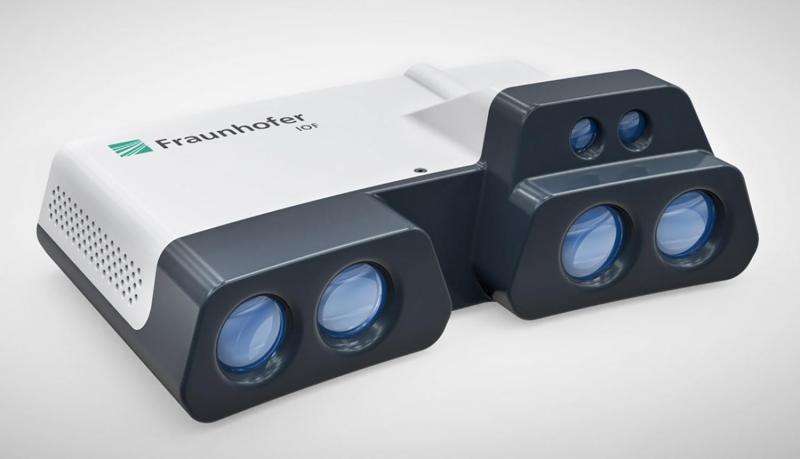With the new infrared 3D scanner, people can be measured without disturbing projections. Credit: Fraunhofer IOF
Infrared 3-D scanners have been used in video games for quite some time. Whereas in video games the scanners are, for example, only able to identify if a player throws his arms up in the air while playing virtual volleyball, the new 3-D scanner of the Fraunhofer Institute for Applied Optics and Precision Engineering IOF is able to be much more precise. With a resolution of one million pixels and real-time data processing, numerous applications are possible with this new device.
"The measuring technology works in a similar way to human vision. However, instead of two eyes we are using two near-infrared cameras", Stefan Heist from the Fraunhofer IOF explains. "In order to detect the object, we project a-periodic patterns onto the surface using a specially developed near-infrared projector." A sequence of different patterns is projected in rapid succession in order to record as many measurement points as possible by the two cameras. Within a few milliseconds, the software then calculates the 3-D data from the images.
Well-balanced overall package
Since infrared rays are invisible to the human eye the scanner measures the surface invisibly and, due to the numerous measurements points, with high accuracy. This makes it possible to create high-resolution 3-D images of 1,000 x 1,000 pixels at 36 3-D images per second. Combined with the shots of a color camera, colored 3-D images are produced in premium quality. The system is able to creates images continuously without a break. This creates the impression of a moving 3-D color image to the viewer. In comparison, old tube televisions showed 25 images per second, each image being doubled in order to reduce the disturbing flicker.
"Although there are scanners that are faster, they render 3-D images with a poorer resolution. If, on the other hand, the scanners are more accurate, they tend to be much slower. Moreover, most scanners work in the visible range and the projections of the patterns may even interfere or have disturbing glare effects. Our measurement goes on completely unseen. The novelty of our development is the finely tuned overall package – and this is still one of the greatest challenges in development work", says Dr. Peter Kühmstedt, who heads the research project.
Numerous applications possible
Numerous applications are imaginable for the new, irritation-free 3-D scanner; for example, in medical rehabilitation. "Here, our optical system could indicate whether the patient performs exercises correctly or incorrectly", says Kühmstedt. He and his team are also working on applications in human-machine interaction. Robots or highly autonomous systems would be able to grasp and respond to human gestures and facial expressions. The new scanner could also be interesting for security technology applications. Biometric body characteristics can be identified without irritating projections.
A prototype of the new scanner has already been built and will be presented at the Stuttgart Control Trade Fair from May 9 to 12.
Provided by Fraunhofer-Gesellschaft
























